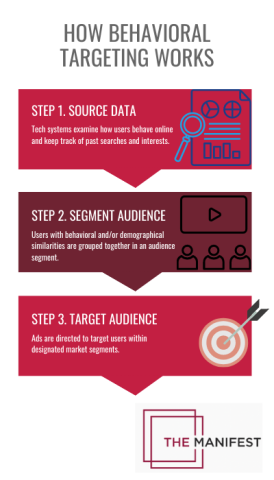How to Use Behavioral Targeting and Navigate Regulations

How to Use Behavioral Targeting and Navigate Regulations
Anticipating user behaviors and interests is a core goal of advertisers everywhere. Behavioral advertising uses technology that makes difficult advertising decisions and audience segmentation easy. After considering the pros and cons, advertisers should consider incorporating behavioral targeting into their advertising practices.
Technology has changed advertising vastly and seemingly constantly since online advertising started to take off in the 1990s. Since then, the space has become extremely saturated and competitive.
Industry experts often express that it's easier to lose money in online advertising than it is to make money. Now more than ever, it’s important that advertisers put their dollars toward connecting with their intended audience.
Behavioral targeting is just one of several ways advertisers can make sure they’re allocating their budgets most effectively — by targeting types of people who should see their ads. By leaning into adtech and behavioral advertising, companies can see sales skyrocket.
There are still considerations and potential blockers to account for in behavioral advertising, so businesses should spend time researching before adopting the process.
Need assistance with behavioral targeting? Connect with top PPC firms on The Manifest.
What is Behavioral Targeting?
Behavioral targeting is the process of using adtech and AI to construct well-defined user profiles based on preferences and search behaviors. Once completed, the user profiles are used to create more effective advertising campaigns that appeal to desired audience segments.
By serving users advertisements they’re more likely to resonate with, clicks, conversions, and sales follow.
Behavioral targeting is also meant to benefit customers. By connecting advertisers with user traits, companies can craft superior customer experiences. While consumers may be put off by being closely targeted through advertising, most expect personalization from their experience with companies online.
Why is Behavioral Targeting Important?
Behavioral targeting is important because of its potential to create engaging customer experiences. AI-based tech is only becoming smarter and more accurate with time.
However, behavioral targeting is also underutilized by advertisers. Despite its ability to bring in new, perfect-fit customers, very few advertisers actually invest in it. An Adobe study found that 76% of digital marketers weren’t targeting their audience based on their online behaviors.
The increased reach that behavioral targeting offers shouldn’t be ignored. Given the saturation of ads and content on search engine results pages (SERPs) and social media, it’s more important than ever to find a way to stand out to the right people.
For instance, say you’re a flower shop that’s looking to connect with customers looking for bridal bouquets. A quick Google search indicates that it’s going to be challenging to compete for this keyword.

Between visual ads, SERP listing ads, photos, and a “people also ask” (PAAs), it takes a couple of scrolls to even reach the organic content rankings.
In this scenario, a flower shop may want to target users based on a certain quality or trait to reach brides at a specific point in their wedding planning journey.
For example, they can target women who have visited other wedding planning sites, indicating that they're planning a wedding and may need flowers. Behavioral targeting allows companies to cut through some of the noise in saturated advertising spaces.
Is Behavioral Targeting Ethical?
It isn’t breaking news that people try to avoid ads, especially those that keep track of their online habits and behaviors. Many consumers are against having their behavior tracked by cookies and used to create user profiles.
Using technology to create targeted ads may not seem ethical if people don’t want you or other companies snooping on them. However, there are a few precautions you can take the ensure you’re being as ethical as possible in creating targeted advertising campaigns:
Behavioral Targeting Best Practices
- Give consumers visibility into your process
- Avoid misleading consumers about policies and products
- Allow consumers to opt-in rather than opt-out
These are just a few ways to uphold open lines of communication between your company and its target audience. In committing to these approaches, you’re more likely to forge a positive, trusting relationship with your customers — even if you choose to invest in behavioral advertising.
1. Give Consumers Visibility into Your Process
Customers are worried about the safety of their personal information in the context of targeted advertising practices. Help them understand how you’re keeping their information safe in the process.
You can do this by creating and displaying a privacy policy that details what information is collected, how it’s used, and how they can manage or control their information. Google’s privacy and terms is particularly thorough and can be looked to as a source of inspiration for what to include in your privacy policy.
This will be reassuring for consumers, who value retaining control over their personal data. Within a privacy policy, you can also indicate ways in which consumer data is stored and protected. Knowing that collected data is safe from cyber attacks will help put their minds at ease.
2. Avoid Misleading Information
This goes both for advertising content and privacy policy information.
Your goal should be to establish a trusting relationship with your audience, not manipulate them into something that they wouldn’t want. If you’re tempted to obscure the truth on either an ad or policy statement, you’re probably not acting in the best interest of your customers.
Targeted ads, if handled respectfully, make a world of a difference to consumers. They are more easily connected with products they’re interested in and enjoy a more personalized buyer experience.
Misleading ad copy or privacy statements are only going to drive a wedge between you and your audience. It will be difficult to earn back their trust if you choose to mislead them.
3. Let Customers Opt-In Rather than Opt-Out
Data collection for ad targeting doesn’t have to be mandatory for everyone. Some users may appreciate getting a more personalized experience in exchange for their data, and others may not.
If you want to reap the benefits of targeted advertising without facing an ethical dilemma, consider having consumers opt-in to data collection as opposed to opting out.
What’s the difference between opting in and opting out? The level of active control you give to your audience is the driving force distinguishing the two .
For instance, say you’re interested in targeting users via cookies on your site:
Opting in: Before any data or information is pulled from users, they have to opt-in or agree to your company collecting data from them.
Opting out: It is assumed that users consent to their data being collected in your site until they opt out or go through a process of rejecting cookies.
Allowing customers to opt in rather than opt out can make a huge impact on how they view your policies. By doing this, you’re encouraging concerned customers to proactively protect their data on their own instead of having to retroactively reclaim control from you.
Changes in Behavioral Targeting Policies
Because of privacy concerns among people and their personal data, behavioral targeting is being phased out of existence by a few major players in digital advertising.
Both Google and Meta (Facebook) are actively taking measures to control the harmful effects of behavioral targeting as it has existed in previous years.
Additionally, state laws are beginning to regulate how companies are able to use behavioral advertising, California and Virginia serving as early adopters.
Google Moves Away from Targeting Individuals
Google is making some adjustments to their policies concerning consumer data.
Google announced that it will stop allowing third-party cookies in its Chrome browser in 2020, stating that the process will be complete in 2022. Additionally, Google will no longer provide user-level profiles for advertisers on sites that aren’t Google itself.
Instead, advertisers will have to use their own databases to target users on Google-owned sites. This is a major change that marks a transition away from building profiles to target specific individuals.
Rather, Google invites advertisers to target larger cohorts of people using aggregate data. The search engine is introducing Topics as part of its Privacy Sandbox initiative, which lets advertisers target groups based on interests while providing additional layers of control and protections to users.
Meta (Facebook) Does Away with Sensitive Targeting
Back in 2019, Mark Zuckerberg and Facebook (Meta) were under fire for allowing misleading targeted ads on the platform.
It was discovered that the company was aware that microtargeting could be easily exploited, especially by politicians looking to spread misinformation for their benefit.
Since, Meta (Facebook) has decided to make an effort to minimize the potential for harm within its advertising programs. At the start of 2022, the company decided to remove sensitive targeting options.
The company states that the following traits can no longer be targeted by advertisers:
- Sexual orientation
- Religion
- Health issues
- Political alignment
- Social issues, causes, or organizations
These limitations are intended to prevent abuse by advertisers and protect users. While this negatively affects some advertisers, Facebook offers a list of possibilities for these organizations to continue to engage with users.
How Does Behavioral Targeting Work?
Behavioral targeting can be broken down into three core steps. Companies that wish to achieve the perks of behavioral advertising must follow each step closely:

When successfully applied to ad campaigns, these steps allow behavioral targeting to function and bring in new customers.
1. Source and Analyze Data
Sourcing and analyzing data may sound like a daunting and manual task, but it’s actually pretty straightforward. For example, if your website uses cookies, that means that a ‘cookie’ gets sent to their computer when someone clicks on your website.
Cookies vary in how long they’re stored on your computer — some are deleted as soon as the user closes their browser, while others remain for longer. These cookies examine user activity while they remain on the site.
After many people have visited your site, the cookies will collect more and more information about user behavior on your site or online. This information about customer web browsing habits can now be analyzed.
This data likely reveals trends in on-site behavior that companies can use to begin learning more about their audience and areas for improvement on the site. Once the data is collected and organized, you’re ready to move on to segmenting your audience.
2. Segment Your Audience
Segmenting your audience is incredibly important in ensuring that you’re targeting the right audience group. After you have a data set containing how users interact with site content, it’s time to begin grouping individual users into audience groups.
In this process, you’ll dive further into the trends and patterns found in the analysis stage. Here, users will be grouped based on their online behavior and traits. For instance, all people who search and buy coffee online may be grouped together.
Because cookies exist on company sites, segmentation can also yield groups of people who repeatedly return to a certain page or those who make repeat purchases of certain products.
You likely already know who your intended audience is prior to this exercise. However, this process will help you better understand whether there are any gaps between your intended and existing audience as well.
3. Create Targeted Ads
Next, simply design and create ads based on your target audience's behaviors and preferences. Now that you have your audience segmented into groups, you can create ad content that caters specifically to those defining traits.
Once you have your ads designed, navigate to the platform you intend to use for advertising and publish your ad according to their platform’s process. For instance, you can find Google’s step-by-step checklist here.
By making your advertising campaigns purposely relatable to your audience, your chances of converting users increase significantly.
Why Behavioral Targeting Boosts Sales?
Even with changes in policy and tightening restrictions surrounding behavioral targeting, targeted advertising will still be of significant value to advertisers now and in the future.
Behavioral targeting gives advertisers a high level of control over who their ads are being directed toward. Companies don’t have to invest huge dollar amounts to resonate with the right audiences, and consumers benefit from being served ads that reflect their needs.
Additional Reading
